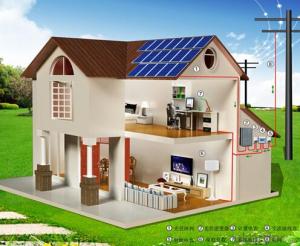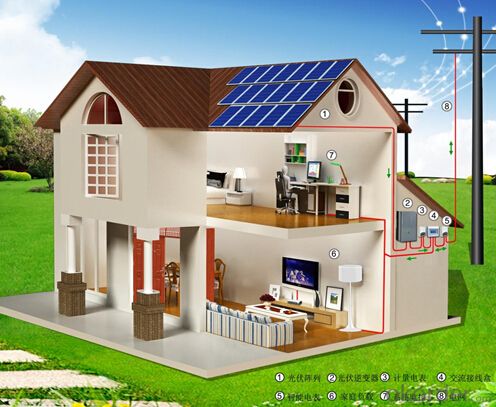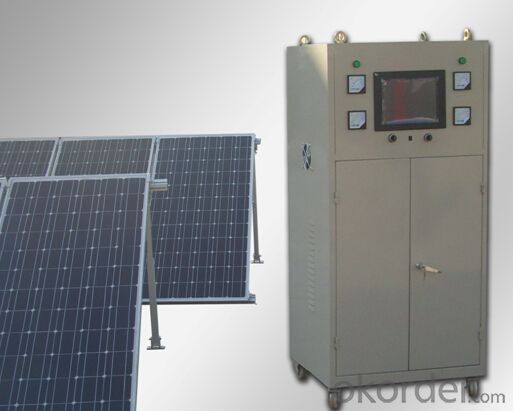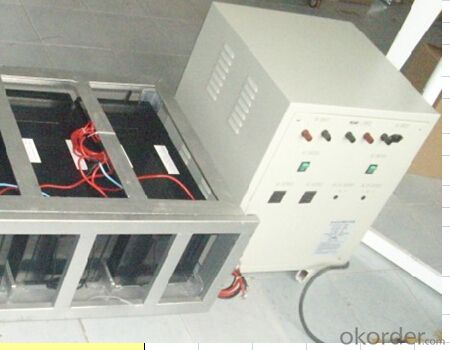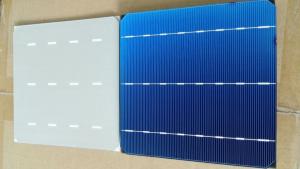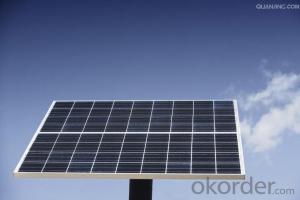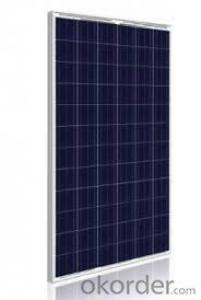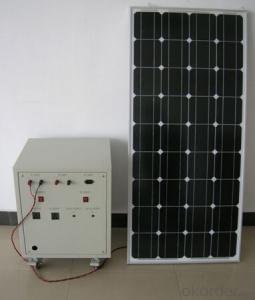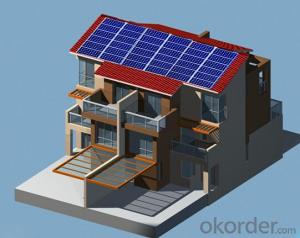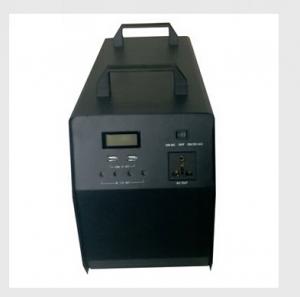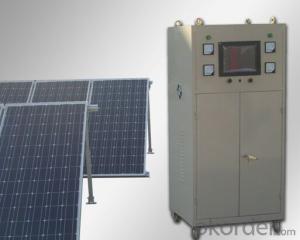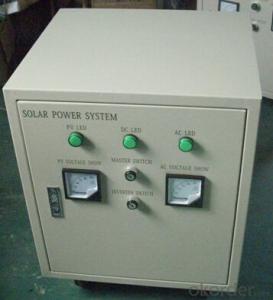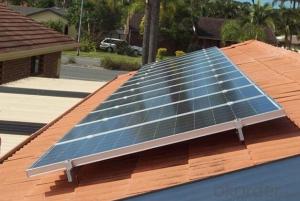Solar Energy CNBM Solar Roof Solar System 10000W with High-Efficiency Solar Cells - Popular in Africa
- Loading Port:
- Shanghai
- Payment Terms:
- TT OR LC
- Min Order Qty:
- 1 PCS
- Supply Capability:
- 3000 PCS/month
OKorder Service Pledge
OKorder Financial Service
You Might Also Like
Introduction of Solar Home System
Solar arrays are designed to provide specified amounts of electricity under certain conditions. The following factors are usually considered when determining array energy performance:
Characterization of solar cell electrical performance
Determination of degradation factors related to array design and assembly
Conversion of environmental considerations into solar cell operating temperatures
Calculation of array power output capability.
The amount of electricity required may be defined by any one or a combination of the following performance criteria:
Power output -- power (Watts) available at the power regulator, specified either as peak power or average power produced during one day.
Energy output -- the amount of energy (Watt-hour or Wh) produced during a certain period of time. The parameters are output per unit of array area (Wh/m²), output per unit of array mass (Wh/kg), and output per unit of array cost (Wh/$).
Conversion efficiency -- defined as "energy output from array" ÷ "energy input from sun" × 100%.
This last parameter is often given as a power efficiency, equal to "power output from array" ÷ "power input from sun" × 100%. Power is typically given in units of Watts (W), and energy is typically in units of Wh, or the power in Watts supplied during an hour.
To ensure the consistency and quality of PV systems and increase consumer confidence in system performance, various groups -- such as the Institute of Electrical and Electronics Engineers (IEEE), the International Electrotechnical Commission (IEC), and the American Society for Testing and Materials (ASTM) -- are working on standards and performance criteria for PV systems.
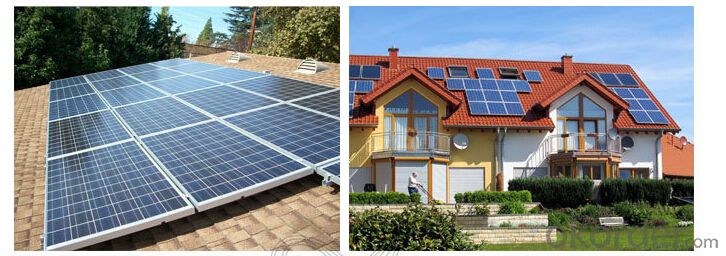


Working Principle of Solar Roof System
The stand alone Solar Home System is an off-grid solar system which uses batteries to store the solar energy. Stand alone solar system solutions design for those who are not able or willing to connect to electricity grid.
Specification of Solar Home System
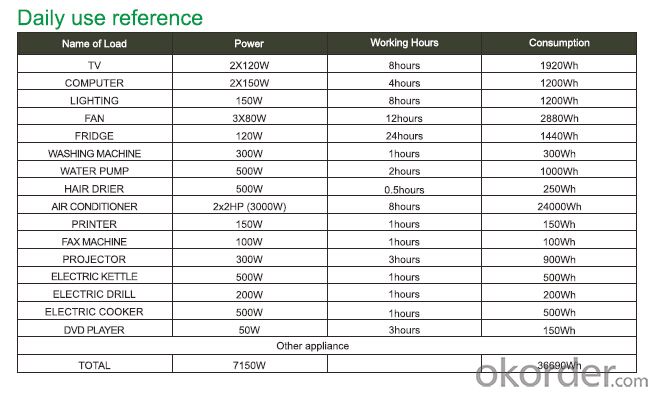
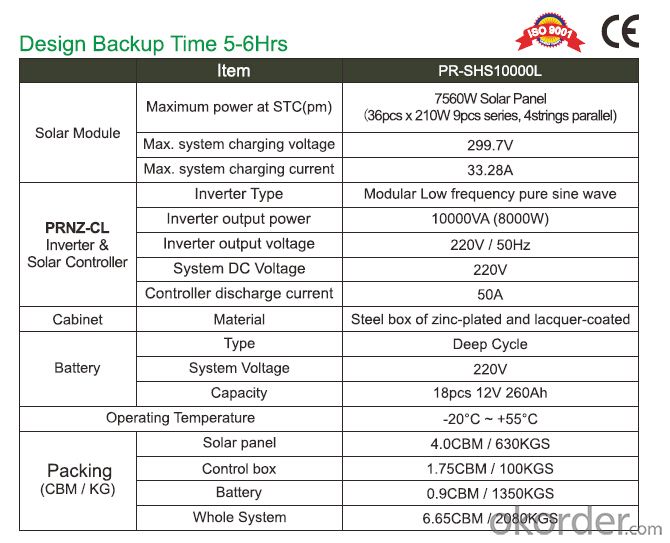
Product Features of Solar Home System
1. Off grid solar power system is mainly used for application with relatively-small power consumption, and the areas have no grid network coverage, or grid power is unstable or outage condition.
2. It’s composed of solar panels, hybrid solar inverter, battery bank, solar panel mounting racks, and other accessories required fora complete home solar power system.
3. The battery bank gives a stable power output to the solar inverter which converts DC to AC to power loads, and provides power backup in rainy or cloudy days.
4. The solar panels generate electricity at daytime and charge the battery bank.
5. The off grid home solar power system provides grid power bypass in case of battery power shortage when sunshine is not enough.
6. All the off grid home solar power system configurations are worked out by scientific calculation and design.
Advantage of Our Solar Home System
1 Excellent Performance: Our Solar Home System is composed by Brand Standard Kits with high quality. Our solar system has the advantage of high efficiency and stable operation. We can ensure our product with a long life period.
2. Small Orders Accepted: We can accept small orders as our customer’s trial order.
3. Warehouse: We have warehouse overseas which can bring great convenience to our customer to pick up the products.
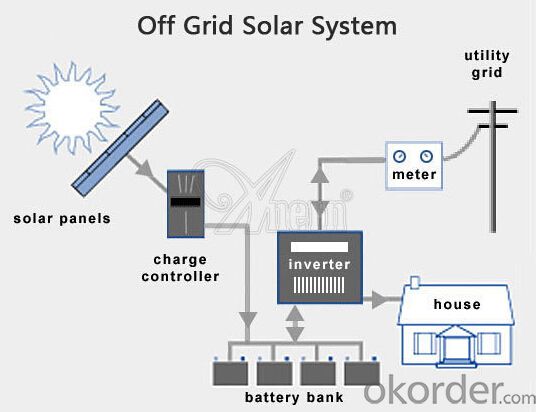
Terms and Conditions
1. Trade terms: FOB Shanghai
2. Payment terms: 30% T/T, balanced before shipment/ LC at sight before shipment. Actual Terms can be negotiated for big order.
3. Package: Exported standard package suitable for tough handling and sea transport.
4. Delivery: Goods to be ready within 10~30 days depending on order quantity.
5. Warranty: 10 years for solar panel, 2 years for controller/inverter/battery.
FAQ
Q: Could you introduce the background of your company?
A: We are a Group corp. with 1GW capacity in China, which is Okorder’s registered VIP Supplier, possess Financial Service from Okorder.com.
Q: Required mainly certificates (CE&IEC/TUV/RoHS)?
A: Our products are certificated by CE RoHS, IEC, ISO, TUV, UL etc.
Q: Your main exported market is?
A: Main markets of our products is: South-east Asia, Mid-east, Arica, East Europe and Latin America.
- Q: What is the role of solar cells in powering traffic signals?
- Solar cells play a crucial role in powering traffic signals as they convert sunlight into electricity, which is then used to operate the signals. By harnessing renewable energy, solar cells eliminate the need for grid connection or reliance on fossil fuels, making traffic signals more sustainable and cost-effective.
- Q: What is the role of power optimizers in solar cell systems?
- The role of power optimizers in solar cell systems is to maximize the energy output of each individual solar panel by ensuring that it operates at its maximum power point (MPP). Power optimizers achieve this by mitigating the effects of shading, module mismatch, and other factors that can decrease the overall performance of the system. They also enable panel-level monitoring and provide important data on the performance of each individual panel, allowing for more efficient maintenance and troubleshooting.
- Q: What is the role of solar cells in powering data centers?
- Solar cells play a crucial role in powering data centers by harnessing the energy from sunlight and converting it into electricity. By installing solar panels on the roofs or surrounding areas of data centers, these cells generate clean and renewable energy to meet a portion of the center's power needs. This reduces reliance on traditional energy sources and helps data centers become more sustainable and environmentally friendly.
- Q: Can solar cells be used in greenhouses?
- Yes, solar cells can be used in greenhouses. They can help generate clean and renewable energy to power various functions in the greenhouse, such as lighting, ventilation, and irrigation systems. By harnessing the sun's energy, solar cells contribute to making greenhouses more sustainable and reducing reliance on fossil fuels.
- Q: What is the role of solar cells in powering electric fences?
- Solar cells play a crucial role in powering electric fences as they convert sunlight into electrical energy, which is then used to charge the batteries that supply power to the fence. This renewable energy source ensures a consistent and sustainable power supply, eliminating the need for traditional power sources or frequent battery replacements.
- Q: Can solar cells be used to power streetlights?
- Yes, solar cells can be used to power streetlights. Solar-powered streetlights use solar panels to convert sunlight into electricity, which is then stored in batteries. This stored energy is used to power the streetlights during the night, making them an eco-friendly and cost-effective lighting solution.
- Q: What is the impact of bird collisions on solar cell performance?
- Bird collisions can have a negative impact on solar cell performance. When birds collide with solar panels, they can cause physical damage to the cells, leading to reduced efficiency and power output. Additionally, bird droppings and debris left behind can create shading and block sunlight from reaching the cells, further decreasing their performance. Therefore, preventing bird collisions is important to ensure optimal functioning and longevity of solar panels.
- Q: Can solar cells be used for telecommunications infrastructure?
- Yes, solar cells can be used for telecommunications infrastructure. Solar cells convert sunlight into electricity, providing a renewable and sustainable source of power. By utilizing solar cells, telecommunication infrastructure such as cell towers, base stations, and remote communication devices can be powered independently, even in remote areas without access to the electrical grid. This helps to reduce reliance on fossil fuels, lower operational costs, and increase the reliability of telecommunications networks.
- Q: Can solar cells be used for powering shopping malls?
- Yes, solar cells can be used for powering shopping malls. By installing a sufficient number of solar panels on the rooftops or in parking lots, shopping malls can generate renewable energy to meet a portion or even the entirety of their power needs. This can help reduce dependence on fossil fuels, lower electricity costs, and contribute to a more sustainable and environmentally friendly operation.
- Q: Is the Photovoltaic cell panel good to save the energy?
- Yes, after being used and tested for years in the market, the photovoltaic cell panel is known to be very good to save energy.
Send your message to us
Solar Energy CNBM Solar Roof Solar System 10000W with High-Efficiency Solar Cells - Popular in Africa
- Loading Port:
- Shanghai
- Payment Terms:
- TT OR LC
- Min Order Qty:
- 1 PCS
- Supply Capability:
- 3000 PCS/month
OKorder Service Pledge
OKorder Financial Service
Similar products
Hot products
Hot Searches
Related keywords
